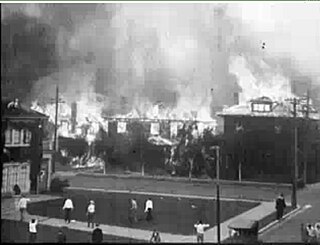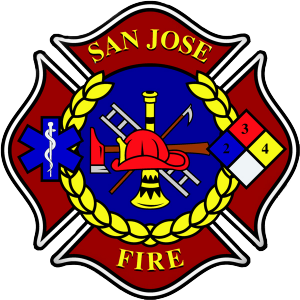The San Francisco Fire of 1863 (October 23, 1863) was a significant fire incident in San Francisco, California, causing substantial damage and displacing numerous residents. [1] [2] [3]
The fire originated at 1:30 AM in the rag store owned by Charley Orley located between Sacramento and California streets, bounded by Davis and Drumm streets. The entire block, primarily consisting of wooden structures, was engulfed by the flames, except for two buildings on the southwest corner and a portion of another on the corner of Drumm street. [2]
The San Francisco Fire Department promptly responded to the scene, and their heroic efforts were complemented by nearly 200 Russian sailors from the Russian fleet anchored in the harbor. Led by Lieutenants Seraggen, Eholen, and Mackaoff, the sailors worked collaboratively with the firefighters, using both buckets and fire engines to combat the blaze. [3]
The fire caused extensive damage, resulting in the complete destruction of the block. Preliminary estimates indicated losses exceeding $100,000 (equivalent to $2.51 million in 2024), impacting businesses and individuals. Many residents lost their homes and possessions, leading to significant hardship. [2]
Firefighters encountered challenges during the containment efforts. The absence of the wind from the west prevented the fire from reaching the city front, but low tide affected access to water sources, complicating the overall firefighting operation. [2]
The Russian sailors played a crucial role in assisting firefighting efforts. On the morning of October 23, 1863, when a large fire broke out, Admiral Popov ordered his squadron to aid the San Francisco fire service. Russian sailors displayed courage and valor in battling the fire. Despite initial use of buckets, they later transitioned to fire engines, working tirelessly alongside the San Francisco fire department. Their contributions were acknowledged by Chief Engineer Scannell and the Fire Department, expressing sincere gratitude. [3]
We must not forget, however, to mention the noble spirit manifested by the Russian fleet now lying in the harbor, the commanding officers of which sent to the scene of conflagration nearly two hundred of their seamen... Each of these gallant "tars" (sailors) came with a bucket; but our good firemen urgently requested the sailors to throw aside their buckets and go to work on the engines. The Russian sailors responded with a good will, and continued until, like their competitors, they were, one by one, almost exhausted, when they took a few moments' rest and then again resumed their positions at the engines. [2]
Many sailors suffered serious injuries, and six Russian sailors lost their lives in the struggle against the fire. The deceased sailors were buried at the Mare Island naval cemetery. The residents of San Francisco expressed gratitude by contributing funds to aid the wounded, and the City Council of San Francisco presented Admiral Popov with a letter of thanks. [3]
The San Francisco Fire of 1863 left a lasting impact on the city's history. The collaborative efforts of firefighters and Russian sailors highlighted the importance of community resilience in the face of calamities. The event underscored the necessity for ongoing fire prevention measures and disaster preparedness in urban areas. [1]
In 1994, commemorating the 130th anniversary of the sailors' sacrifice, the Russian Consulate in San Francisco organized a memorial service and erected new monuments at the graves of the fallen Russian sailors. [4]
On May 9, 2010, a memorial plaque was installed in San Francisco at The Embarcadero near Pier 7. The project received support from the San Francisco Port Commission. The inscription on the plaque reads: "In memory of the selfless and courageous actions of the Russian Imperial Navy sailors while saving the lives of many city residents in suppressing the great fire in San Francisco on October 23, 1863." [5]
The Mare Island Brewing Company released a beer named Six Buckets Russian Imperial Stout, honoring the six fallen sailors. [6]

A fire engine or fire truck is a vehicle, usually a specially-designed or modified truck, that functions as a firefighting apparatus. The primary purposes of a fire engine include transporting firefighters and water to an incident as well as carrying equipment for firefighting operations in a fire drill. Some fire engines have specialized functions, such as wildfire suppression and aircraft rescue and firefighting, and may also carry equipment for technical rescue.

A fire department or fire brigade, also known as a fire company, fire authority, fire district, fire and rescue, or fire service in some areas, is an organization that provides fire prevention and fire suppression services as well as other rescue services.

A fireboat or fire-float is a specialized watercraft with pumps and nozzles designed for fighting shoreline and shipboard fires. The first fireboats, dating to the late 18th century, were tugboats, retrofitted with firefighting equipment. Older designs derived from tugboats and modern fireboats more closely resembling seafaring ships can both be found in service today. Some departments would give their multi-purpose craft the title of "fireboat" also.

Firefighting is a profession aimed at controlling and extinguishing fire. A person who engages in firefighting is known as a firefighter or fireman. Firefighters typically undergo a high degree of technical training. This involves structural firefighting and wildland firefighting. Specialized training includes aircraft firefighting, shipboard firefighting, aerial firefighting, maritime firefighting, and proximity firefighting.

Aerial firefighting, also known as waterbombing, is the use of aircraft and other aerial resources to combat wildfires. The types of aircraft used include fixed-wing aircraft and helicopters. Smokejumpers and rappellers are also classified as aerial firefighters, delivered to the fire by parachute from a variety of fixed-wing aircraft, or rappelling from helicopters. Chemicals used to fight fires may include water, water enhancers such as foams and gels, and specially formulated fire retardants such as Phos-Chek.

Elizabeth Hitchcock Coit was a patron of San Francisco's volunteer firefighters and the benefactor for the construction of the Coit Tower in San Francisco, California.

The New York City Fire Museum is a museum dedicated to the New York City Fire Department (FDNY) in the Hudson Square neighborhood of Manhattan, New York City. It is housed in the former quarters of the FDNY's Engine Company No. 30, a renovated 1904 fire house at 278 Spring Street between Varick and Hudson Streets.

The North Coast Brewing Company is a craft brewery located in Fort Bragg, California. As of 2018, it is the 46th-largest craft brewer by annual sales volume in the United States.

The history of organized firefighting began in ancient Rome while under the rule of the first Roman Emperor Augustus. Prior to that, Ctesibius, a Greek citizen of Alexandria, developed the first fire pump in the third century BC, which was later improved upon in a design by Hero of Alexandria in the first century BC.

The San Francisco Fire Department (SFFD) provides firefighting, hazardous materials response services, technical rescue services and emergency medical response services to the City and County of San Francisco, California.

The 1923 Berkeley, California, fire was a conflagration that consumed some 640 structures, including 584 houses in the densely built neighborhoods north of the campus of the University of California in Berkeley, California, on September 17, 1923.
Andrei Alexandrovich Popov was an officer of the Imperial Russian Navy, who saw action during the Crimean War, and became a noted naval designer.

Phoenix is a fireboat owned by State of California and operated by the city of San Francisco in the San Francisco Bay since 1955. Phoenix is known for helping to save Marina District buildings from further destruction by fire following the 1989 Loma Prieta earthquake. Her worthy assistance resulted in a second vintage fireboat obtained for the city. Both Guardian and Phoenix are based at Firehouse No. 35 at Pier 22½ of the Port of San Francisco. Phoenix often leads parades of ships, and takes part in welcoming ceremonies.

The San José Fire Department (SJFD) provides firefighting, rescue and emergency medical services to the city of San Jose, California, United States. The San Jose Fire Department protects the third largest city in California and the 13th largest city in the nation.
Kalevala, a.k.a. "Calevala", was a propeller-operated corvette of the Finnish navy. The construction of it was completed in 1858 at Turku Old Shipyard, Finland. From 1860 to 1865, the corvette served in the Pacific Fleet of Russia. At the time, Finland was an autonomous grand duchy (1809-1917) within the Russian Empire.

A firefighting apparatus or firefighting appliance describes any vehicle that has been customized for use during firefighting operations. These vehicles are highly customized depending on their needs and the duty they will be performing. These duties can include firefighting, technical rescue, and emergency medical services.
The San Francisco Black Firefighters Association (SFBFA) was founded in 1972.

Fireboats in San Diego have been operated on San Diego Bay by the city of San Diego, California since the early 20th century, as well as by the Port of San Diego since its creation as a quasi-governmental agency serving the entire Bay in 1962.
Firefighting in Antarctica encompasses various organizations and procedures designed to fight fires on the continent of Antarctica. Firefighting in Antarctica is complicated by the harsh conditions of the continent, the remoteness of the locations to be serviced, and the importance of protecting life-supporting shelter from immolation.

During the Roman Republic, there were watchmen that served as firefighters. They used water buckets to put out fires and axes to tear down buildings near the fire in order to prevent the fire from spreading. The aediles and tresviri nocturni were also employed to fight fires. Roman Emperor Augustus created the Vigiles. The Vigiles were an organization of freedmen that fought fires. They would use buckets and water pumps. Emperor Nero also created "bucket brigades" to help fight fires.